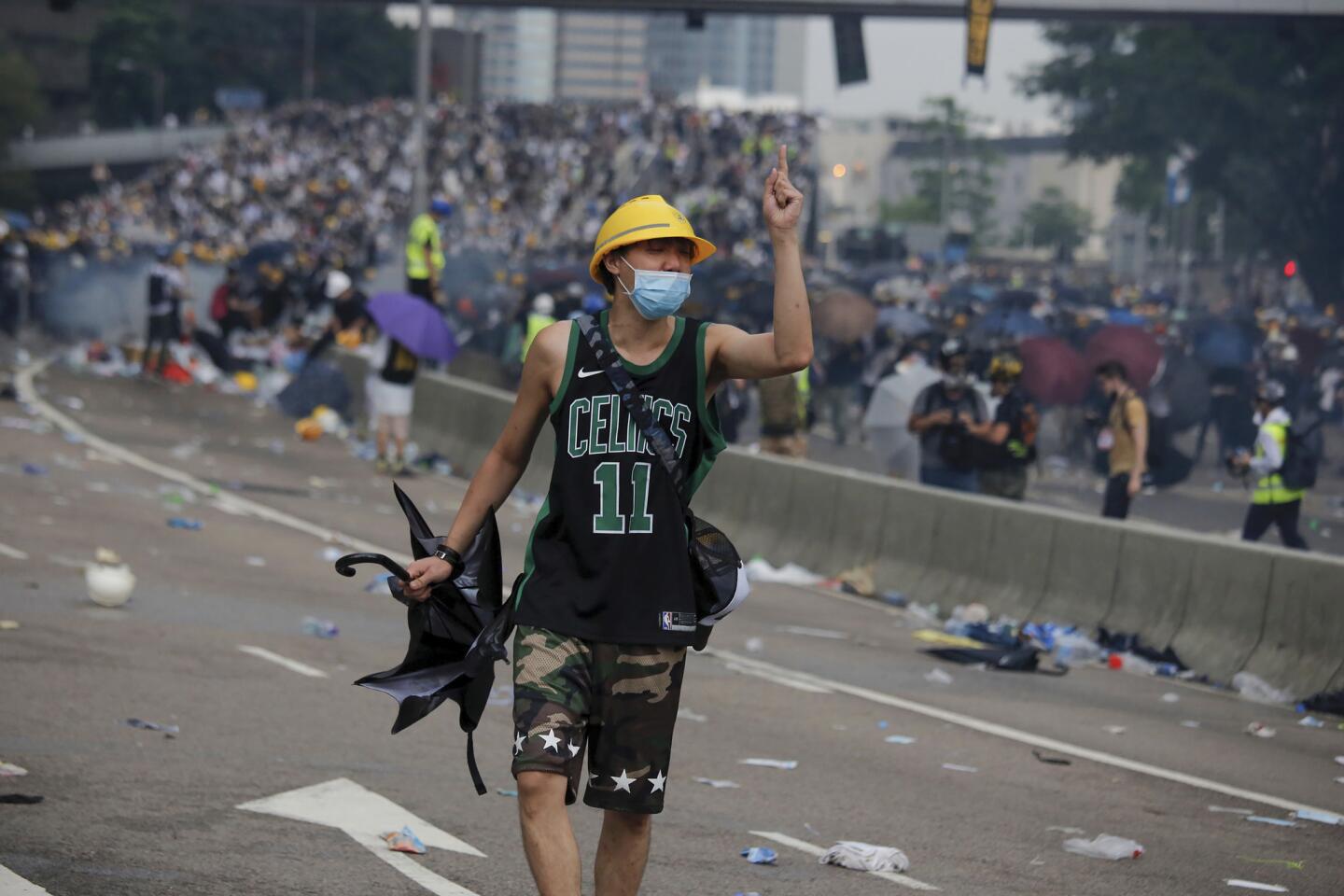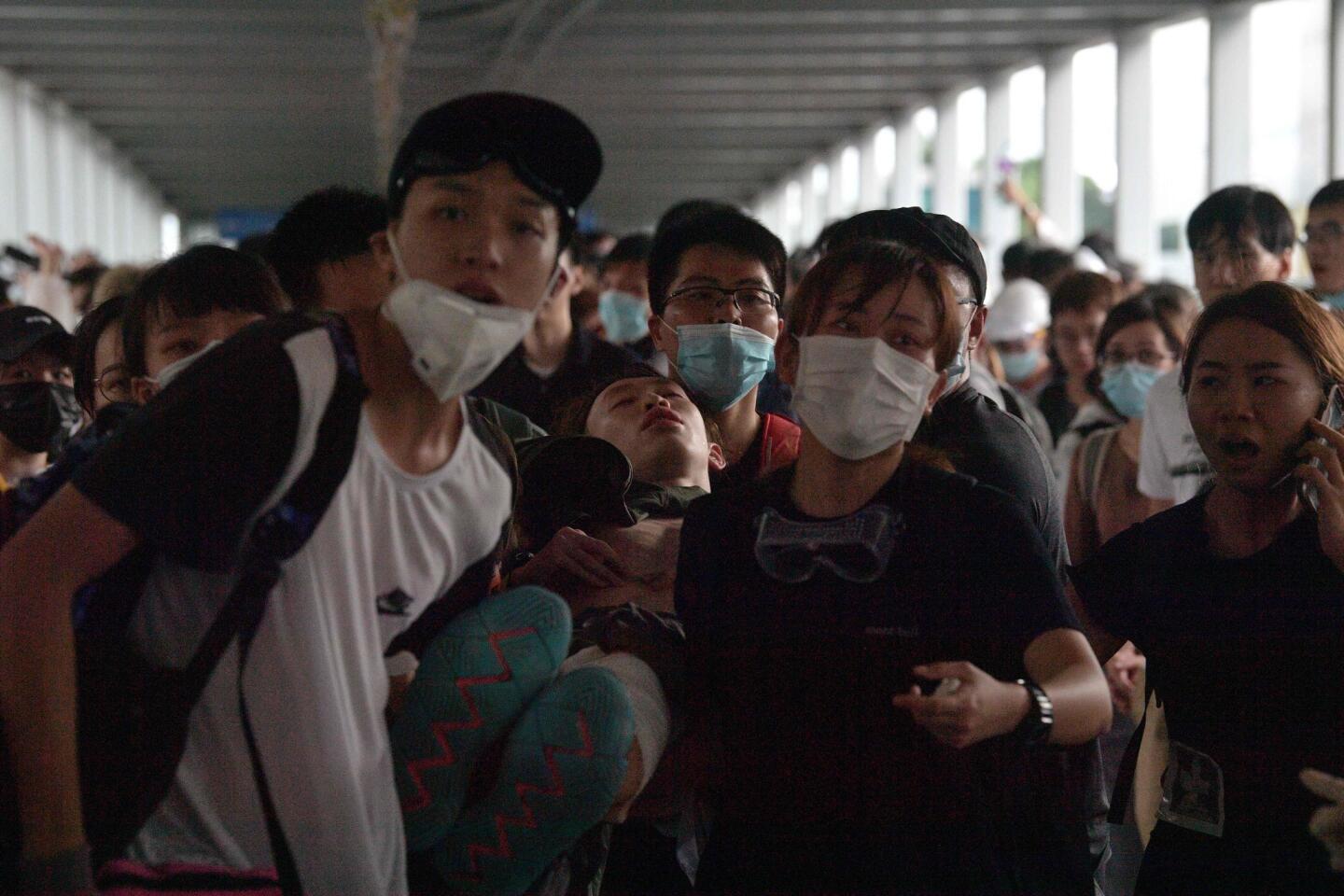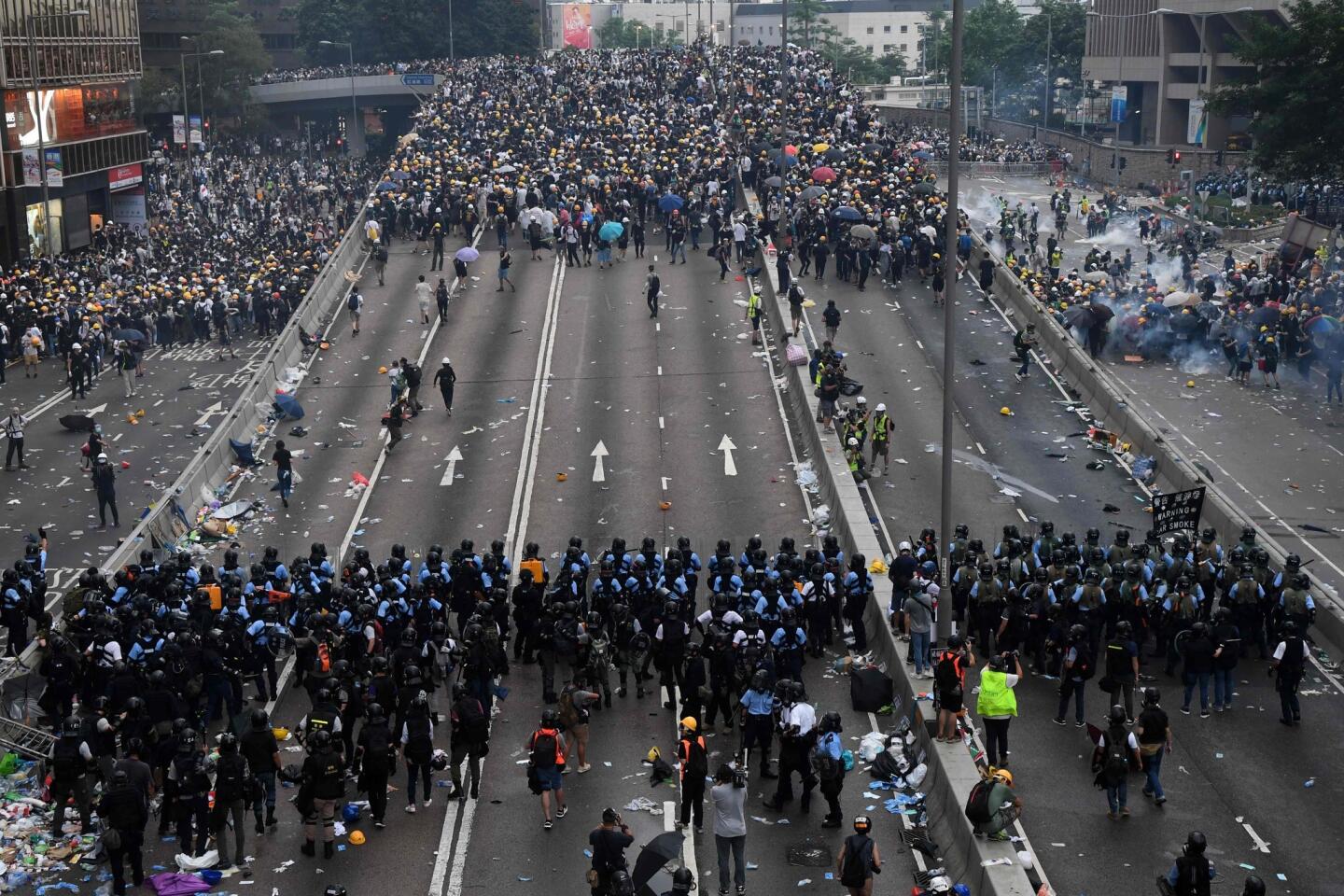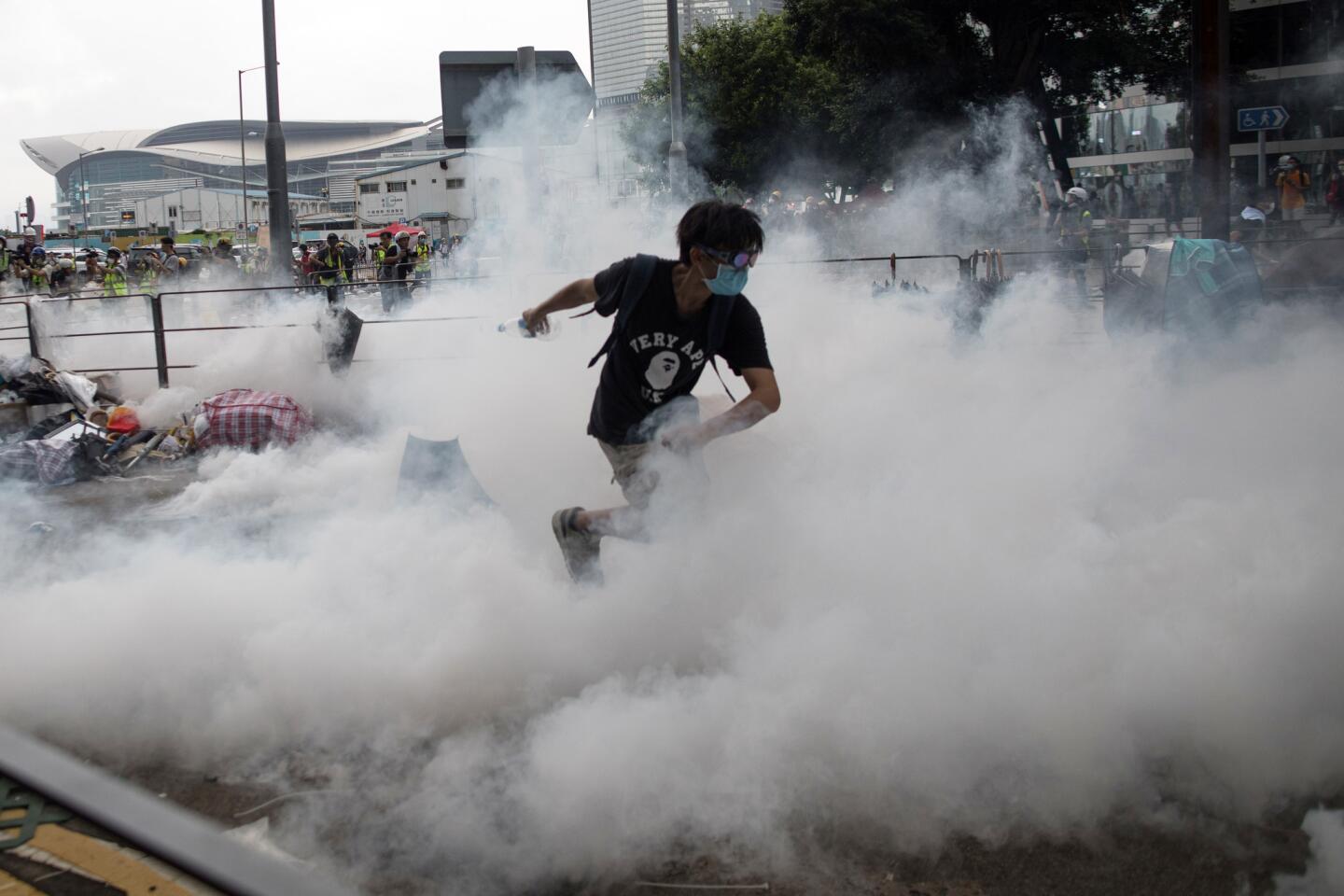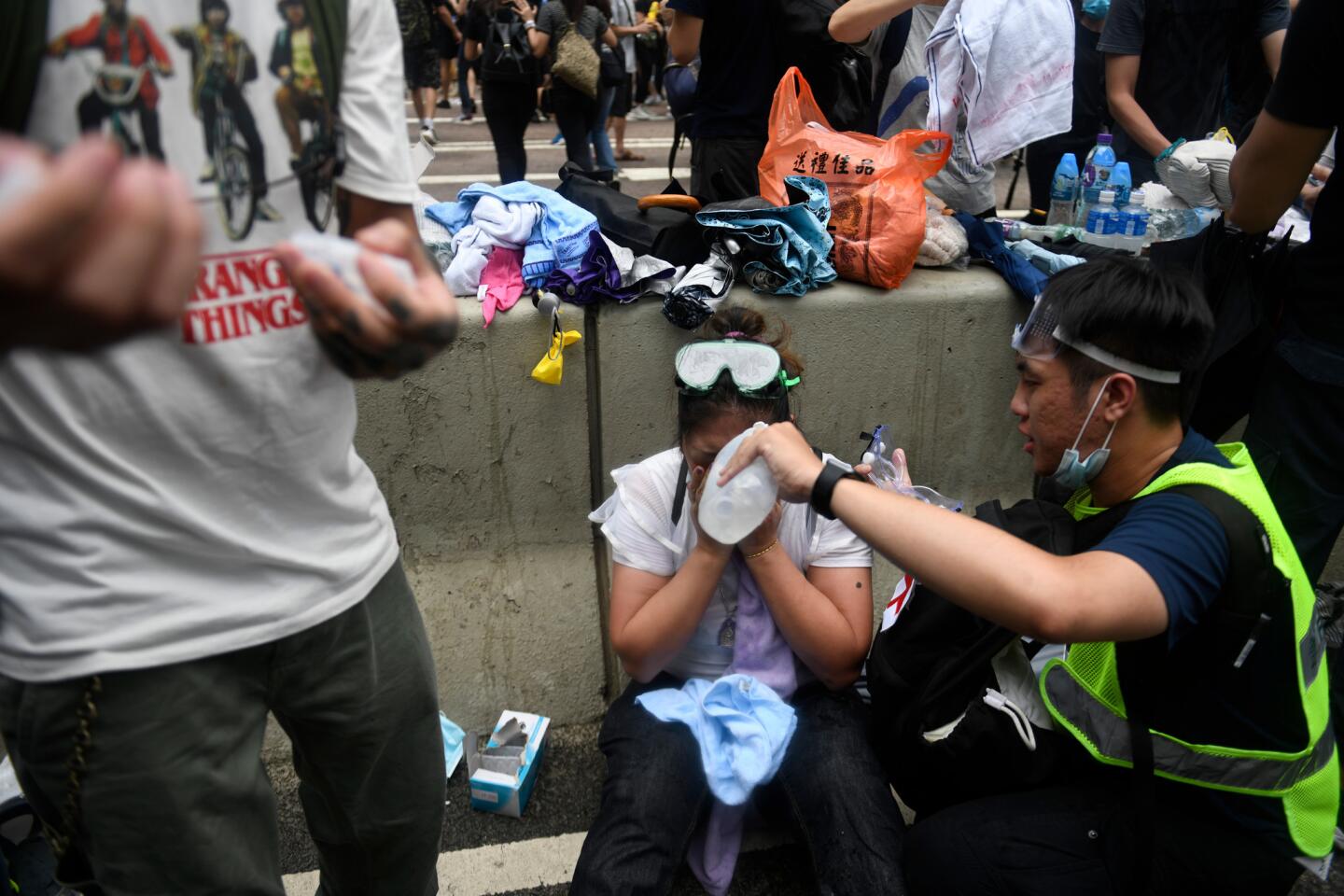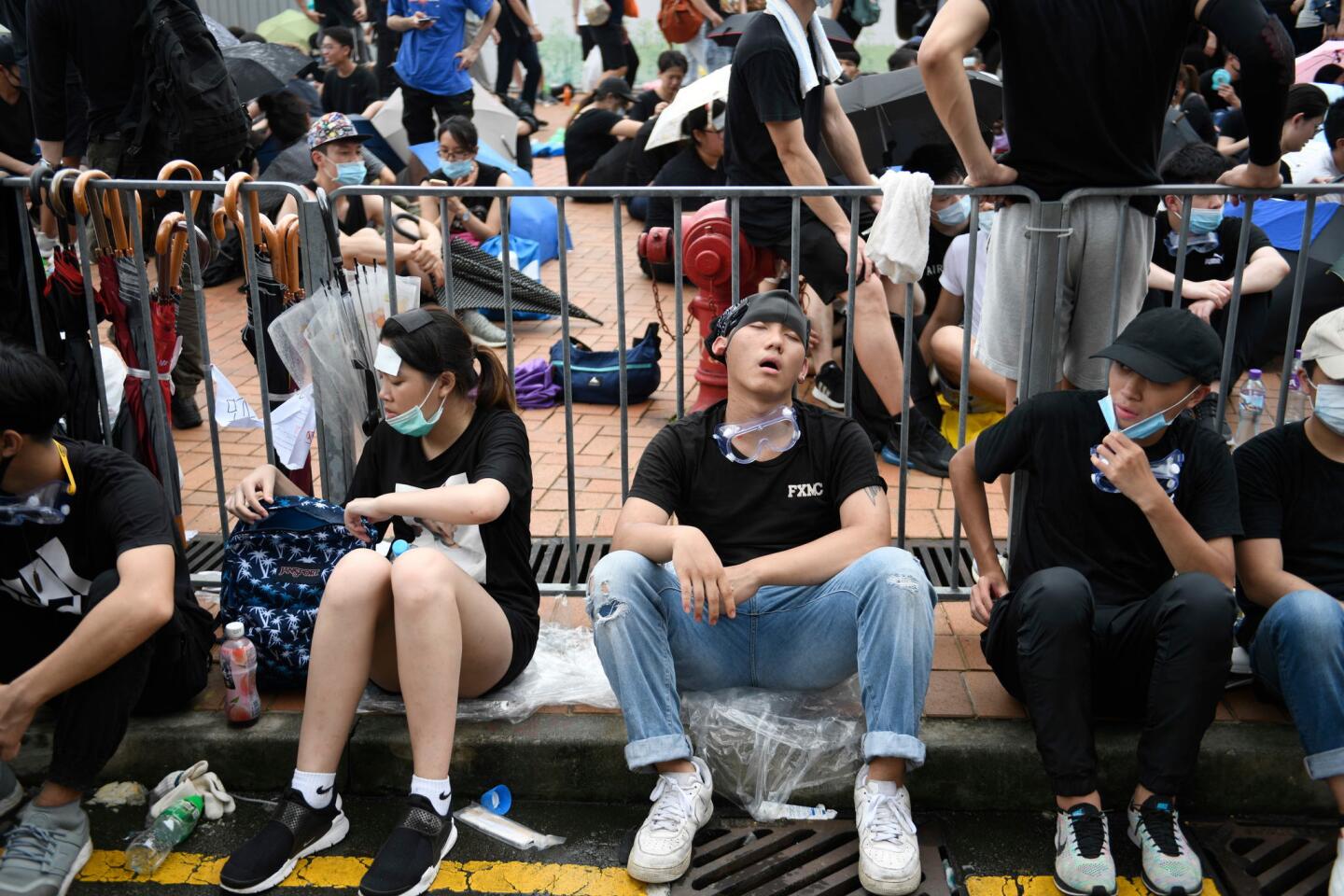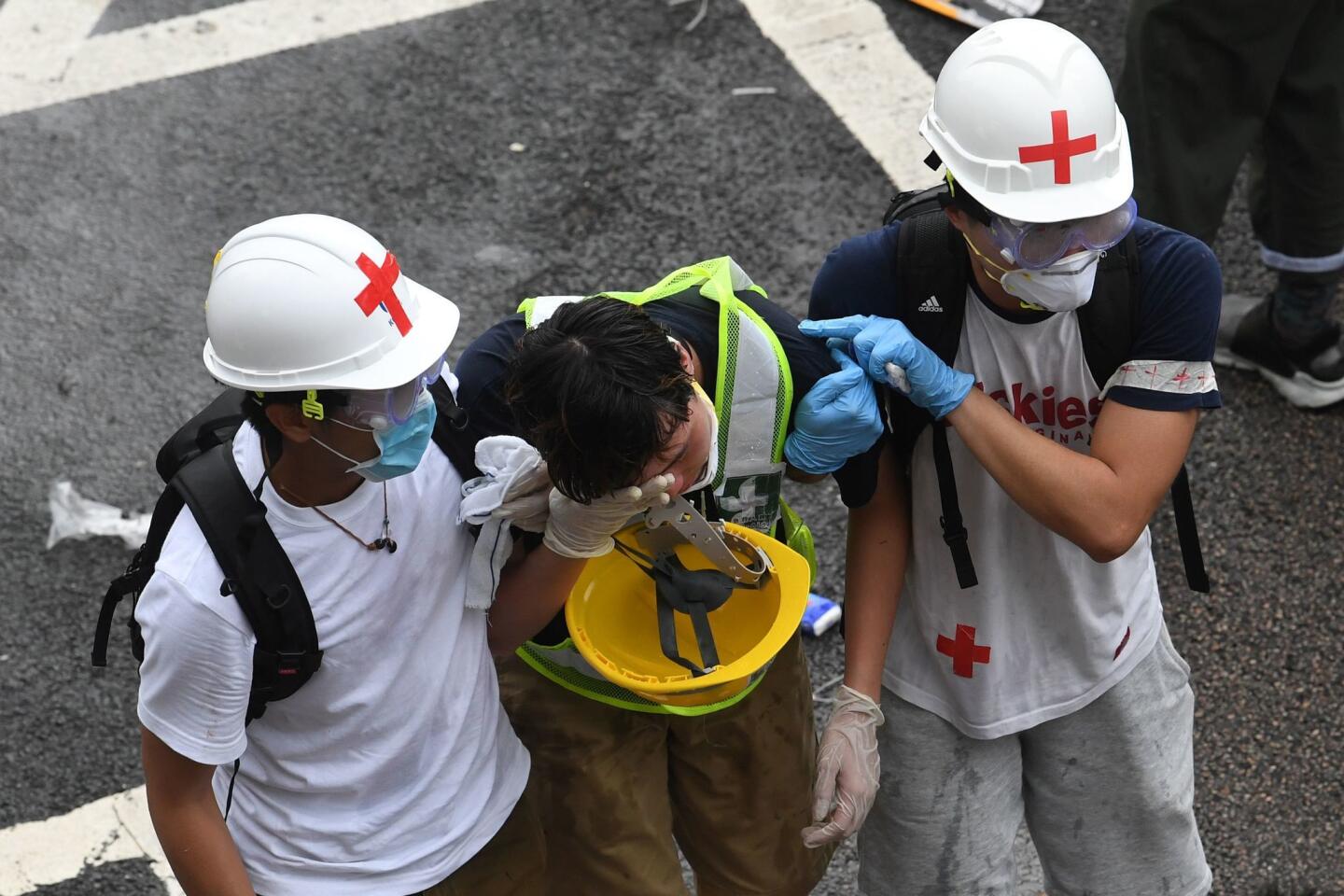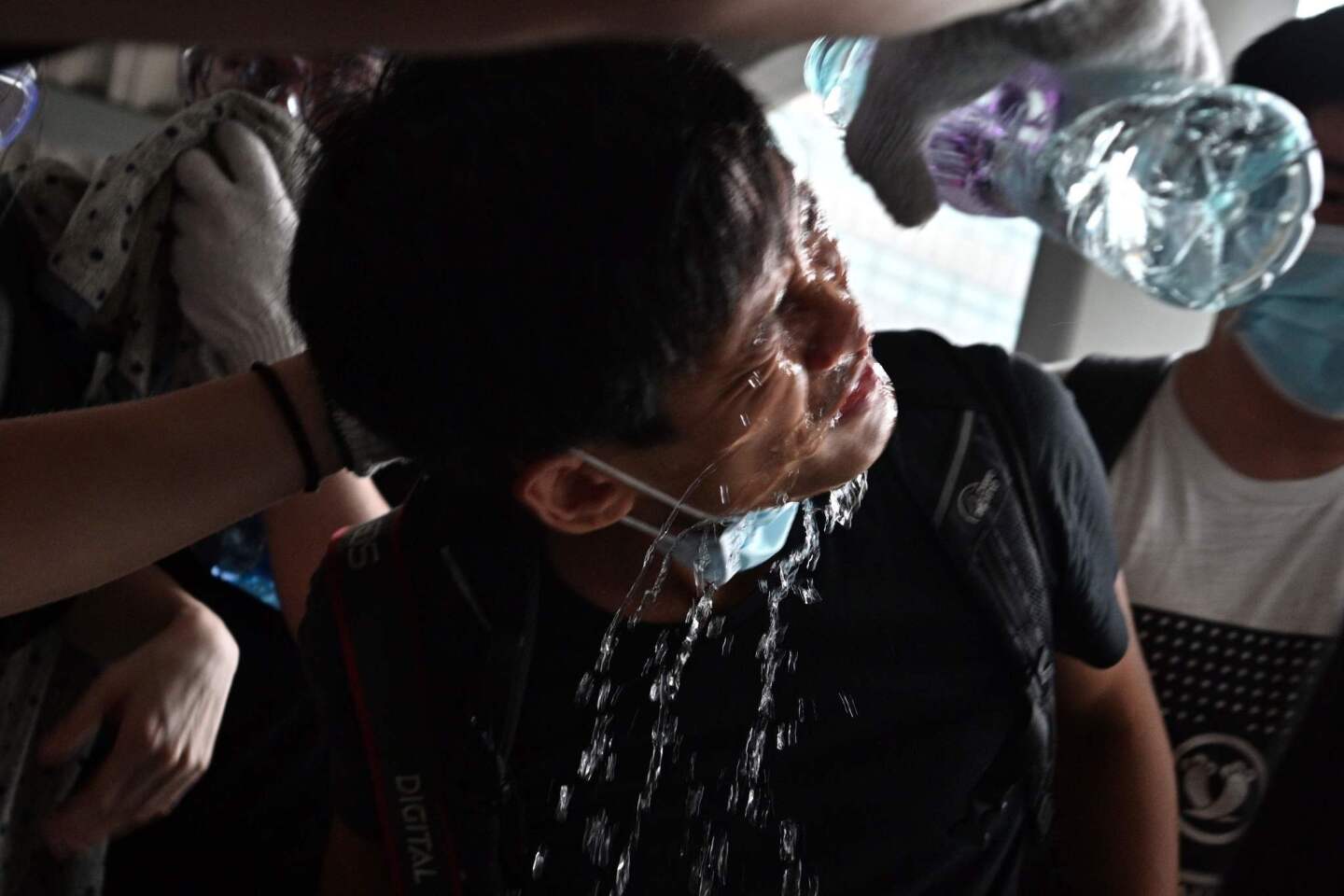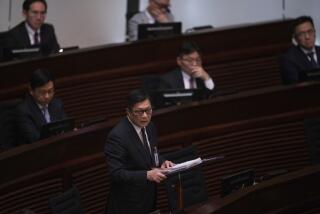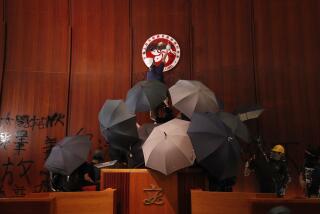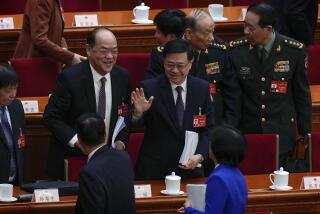Hong Kong extradition bill clashes escalate as police fire tear gas and rubber bullets at protesters

Hong Kong police fired tear gas at protesters massed outside government headquarters on Wednesday.
Acrid clouds of tear gas still hung in the air as Avery Cheng crouched to the ground, weeping, on a pedestrian overpass. Crowds of young protesters in T-shirts and surgical masks sprinted past, coughing and splashing water in their eyes.
Police in riot gear marched toward the running crowds, shooting rubber bullets, bean bags and tear gas canisters, then chasing the mostly unarmed youth with batons and pepper spray.
The protesters ran, rubbing their eyes, then stopped to turn and chant, “Retract! Retract!” Riot police continued to advance.
“This is just so cruel,” said the 19-year-old Cheng.
He’d come to Hong Kong’s legislative center Wednesday morning to protest an extradition bill that would allow Hong Kong to send people to mainland China for trial. Hong Kongers, who don’t have a great deal of trust in China’s judicial system, fear the change would be the end of freedom of speech and assembly that Hong Kong maintains as a semiautonomous region.
More than a million people marched in protest against the bill on Sunday, according to organizers. Yet, Hong Kong’s chief executive, Carrie Lam, said Hong Kong’s Legislative Council would proceed with the bill, discuss it on Wednesday and vote by June 20. The government later announced it would delay discussion of the bill, which is expected to pass despite public opinion because Beijing controls a majority of the legislature.
That didn’t stop tens of thousands of protesters from showing up Wednesday, aiming to obstruct legislative procedures by blocking access to the building.
Hundreds of demonstrators had already arrived at the complex by Tuesday night, some of them church members who sang hymns facing police from 9 p.m. until dawn, waving white flowers in the air.
“We are singing because we want to say that although the government is ruling us, above them there is a Lord who sees what’s happening, who is just, and who knows they lie and everything they do,” said Ryan Tsang, a 26-year-old participant. The older church members were also there to watch over youth protesters and protect them in case violence broke out, he added.
A middle-aged woman handed out slips of advice and free legal hotline numbers in case of detention. Two 22-year-olds wearing face masks helped her pass them out, giving their names as Tony and John but refusing to give last names out of fear that police would target them.
“One million people came out, but it was still useless. We need to upgrade our action. We need to be more aggressive,” Tony said. “As a Hong Konger, this may be the last time we have to stand out.”
The demonstration remained peaceful as dawn broke, though the police presence had escalated steadily, with authorities performing searches and identity checks at the nearby commuter rail station and in the crowds through the night. At least 72 people were reported injured — two seriously — and police arrested 19 people on charges of illegal assembly and obstructing security forces. At least 22 protesters were hospitalized, according to local media.
By 8:30 a.m., thousands of additional demonstrators had begun flocking to the legislative building, blocking access by occupying the streets around it. Volunteers built supply stations filled with water, toilet paper, umbrellas, goggles and cling wrap — to protect from anticipated tear gas — and made assembly lines to pass them toward the road’s center.
It was like the pro-democracy Umbrella Movement of 2014 on fast forward, and demonstrators seemed experienced in the same logistics and nonviolent tactics they’d used five years ago. Volunteers collected trash and set up recycling centers. Others directed pedestrian traffic through the crowded escalators and overpasses.
A row of pastors stood at the entrance to the legislative building, facing a line of police five rows deep. They wanted to keep their bodies in between the police and the youths, they said.
In one corner of a shopping mall, 17-year-old Morgan Chan sat cross-legged on the floor, reading a collection of essays by the 20th century revolutionary Chinese writer Lu Xun.
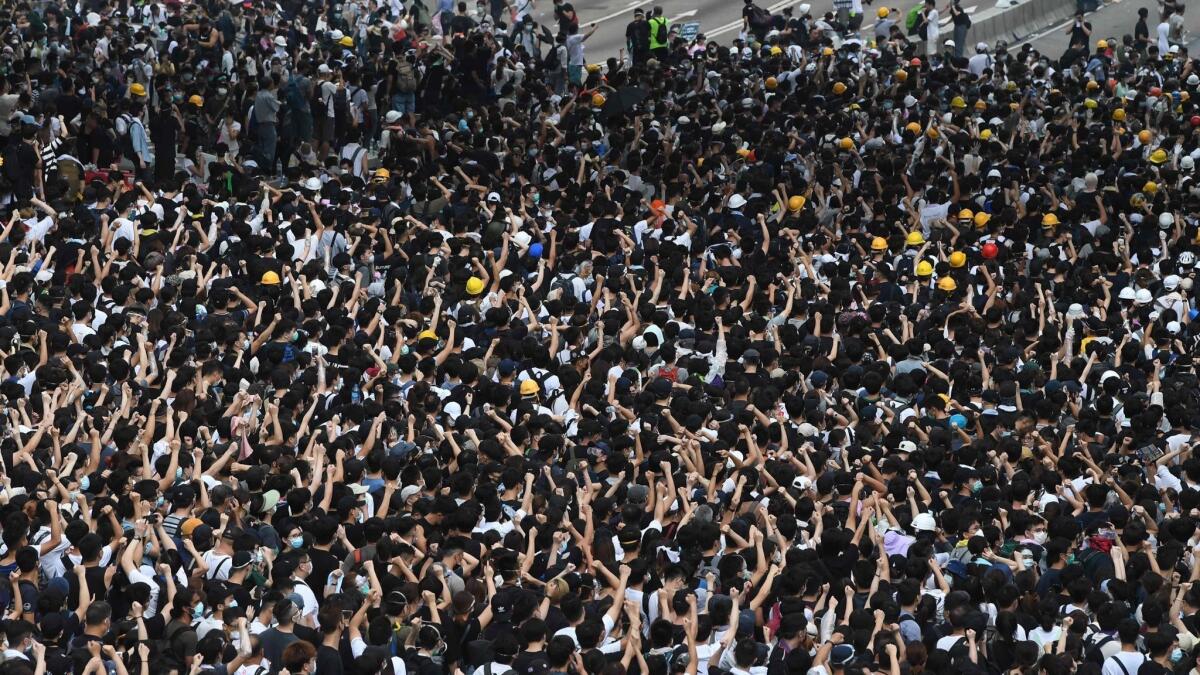
“I’m reading him now because he was against the bad government at that time. So I think we will get some support from this book,” Chan said, flipping to a famous story called Ah Q.
“It’s about how foolish people were in the past, but actually it’s the same right now,” Chan said, adding that those who trusted the government while it “blacklisted” citizens’ human rights were fools. He’d come to protest with his sister, 19-year-old Jojo Chan, even though they didn’t think things would change.
“I know it is impossible to change the minds of the government, but I think we need to do something,” Morgan Chan said. “At least, we need to try.”
Celebration rippled through the crowd at midday as the government announced a delay of the legislative meeting. But protesters decided to stay, worrying that the council might convene and push a quick vote through if they left the scene.
On one pedestrian overpass, a group of hunger strikers sat on the floor, many of them older activists who wanted to support the young. Some were fasting in 24-hour shifts, relay style; others were fasting for 103 hours, to honor the 1.03 million people who’d reportedly marched on Sunday.
“The young people know what they’re doing,” said 71-year-old art curator Jimmy Choi, also on hunger strike. “I’m very proud of our young kids. When they debate with government officials, they often beat them.”
He was fasting in solidarity and in belief that today’s protesters would inspire later generations, he said, just as the 2014 Umbrella Movement had “failed” but planted a seed of resistance in the youth who were out today.
“The mainland government is so powerful. We can’t fight them. We’re fighting a long battle,” Choi said. “But the war, you cannot tell.”
“People think Hong Kongers are too practical and apolitical. It’s not true,” said 50-year-old Jessica Yeung, a professor also on hunger strike. “Hong Kong people are very highly educated. We know what is happening to us and we are very clear what’s our bottom line. The government can’t treat us like this. We know our rights very well.”
Protesters continued to gain ground through the early afternoon, climbing onto highways and pressing against metal barriers as police stood, watching. Cheers burst out when rain began to pour, umbrellas popping open like bouquets opened to the sky above the crowds.
Under one cluster of umbrellas, a group of social workers said they had come because extradition would threaten the work they do with Hong Kong’s most vulnerable people.
“We work with low-income groups, the poor people in Hong Kong,” said Ki Lau, a 30-year-old social worker. Her work often involved raising awareness of unfair or misused government policies, which meant she could be a target if the bill passes.
“If they pass the law, there’s nothing you can do, because the Chinese government can do anything they like and bring you to China and to their court. It’s the endgame,” Ki said. Most Hong Kong people don’t know what to do now, she added.
“We’re just coming out to group the people and stay stronger together, to encourage each other,” Ki said. “We don’t know about the future. It’s going to be bad for Hong Kong.”
Tension began to rise around 3:30 p.m. Protesters had airdropped messages around the demonstration area giving the government a 3 p.m. deadline to retract the bill. If not, the protesters would escalate to extended strikes, obstructing public transport and potentially storming the legislative council building, the messages said.
As the deadline passed, both the crowds and police began to build. Rows of armored police surged out of the legislative building, swarming toward the protesters’ lines. Volunteers in sneakers sprinted toward the protesters’ side, passing boxes of helmets and goggles to the front. The front rows opened their umbrellas.
Clashes broke out on multiple sides of the building at the same time. Some protesters surged forward, throwing water bottles in the air and pushing their way into the legislative building. Police surged as well, wielding batons, shields and pepper spray. Then came the tear gas, mushrooming into the sky and spreading with the wind. The sound of shots filled the air as police fired rubber bullets and bean bags toward civilians.
The crowds ran, umbrellas still raised. They stopped, turned around, many of the youth calling each other to come back and fight again. Police used more tear gas. Some protesters dispersed. Others kept charging back.
Inside the legislative building, lawmaker Charles Mok shouted in distress at the police forces. “This is [the Legislative Council]! Do you think you’re the boss here?” he said. “It’s game over for Hong Kong, do you know?”
By sunset, riot police had forcefully cleared the entire legislative complex, pushing protesters to a new front line in Hong Kong’s central business district. Discarded masks, torn banners and tear gas canisters littered empty streets where crowds had sung in vigil the night before.
Rage and grief began to build. The teachers’ union announced a citywide strike. Hong Kong Red Cross set up emergency relief stations. Thousands of protesters remained on the streets, barricading themselves against the police. The government shut down the closest commuter rail station.
As riot police continued to advance toward protesters, Lam, the chief executive, interrupted news broadcasts with a televised statement, saying the protests were organized riots.
“It’s impossible these actions show love for Hong Kong,” Lam said. “If you pursue your goals with radical and violent means, these scenes will just get worse.”
Lam also gave a broadcast interview to local media, weeping on-screen and saying she’d made many sacrifices for Hong Kong, to the point where her husband said she’d “sold [herself] to Hong Kong” rather than selling out Hong Kong.
Pro-democracy legislators condemned police “abuse of force” and called for mass strikes on television.
“Hong Kongers have by no means rioted!” the Civil Human Rights Front, organizers of the Sunday march, said in a statement. “The protest today took place solely because Carrie Lam ignored the voice of 1.03 million people, and refused to withdraw the extradition bill. Carrie Lam is fully responsible for the fury of people!”
The statement also urged the international community to intervene, to condemn the police crackdown and to urge the Hong Kong government to withdraw the bill.
As night fell, riot police set off tear gas in the central business district and began advancing through the streets again, attacking the protesters and their metal barricades as onlookers cried, “Shame on you!”
One person shouted, “This is our Hong Kong, this is not Carrie Lam’s Hong Kong.” Another yelled, “Where is your conscience? Respect yourself, you’re human too.”
Protesters ran and regrouped, still chanting “Retract! Retract!”
More to Read
Start your day right
Sign up for Essential California for news, features and recommendations from the L.A. Times and beyond in your inbox six days a week.
You may occasionally receive promotional content from the Los Angeles Times.
